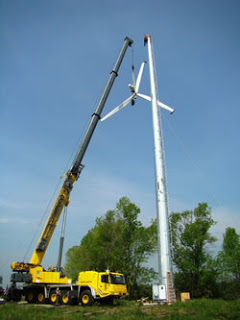
by jboullion | Jul 7, 2010 | Uncategorized
As daylight fades, Manhattan continues to gorge on power. New York City is tied to fuels like natural gas, with less than one percent of its electricity coming from wind or solar.
From an article by Joel Achenbach in National Geographic, with photos by Joe McNally
Can we fix the infrastructure that powers our lives?
We are creatures of the grid. We are embedded in it and empowered by it. The sun used to govern our lives, but now, thanks to the grid, darkness falls at our convenience. During the Depression, when power lines first electrified rural America, a farmer in Tennessee rose in church one Sunday and said—power companies love this story—”The greatest thing on earth is to have the love of God in your heart, and the next greatest thing is to have electricity in your house.” He was talking about a few lightbulbs and maybe a radio. He had no idea.
Juice from the grid now penetrates every corner of our lives, and we pay no more attention to it than to the oxygen in the air. Until something goes wrong, that is, and we’re suddenly in the dark, fumbling for flashlights and candles, worrying about the frozen food in what used to be called (in pre-grid days) the icebox. Or until the batteries run dry in our laptops or smart phones, and we find ourselves scouring the dusty corners of airports for an outlet, desperate for the magical power of electrons.
The grid is wondrous. And yet—in part because we’ve paid so little attention to it, engineers tell us—it’s not the grid we need for the 21st century. It’s too old. It’s reliable but not reliable enough, especially in the United States, especially for our mushrooming population of finicky digital devices. Blackouts, brownouts, and other power outs cost Americans an estimated $80 billion a year. And at the same time that it needs to become more reliable, the grid needs dramatic upgrading to handle a different kind of power, a greener kind. That means, among other things, more transmission lines to carry wind power and solar power from remote places to big cities.
Most important, the grid must get smarter. . . .
by jboullion | Jul 6, 2010 | Uncategorized
From an article by Larry Sandler of the Milwaukee Journal Sentinel:
But expansion of I-94 finds increased support
Support for new rail transit systems has dipped below 50% in the Milwaukee area, while I-94 expansion receives stronger backing but still falls just short of a majority, according to a recent poll.
At the same time, The People Speak Poll found majority support throughout the four-county area for a new half-cent sales tax in Milwaukee County only to fund the county’s transit system, despite skepticism about empowering a regional transit authority to levy a broader sales tax.
The Public Policy Forum’s People Speak Poll is a tracking poll, designed to follow changes in public opinion on key local issues over time. The latest telephone poll of 386 residents in Milwaukee, Waukesha, Ozaukee and Washington counties focused on transportation issues and was the third such poll in a year to ask about plans for high-speed trains, commuter rail and streetcars.
Last fall, 57% backed plans for high-speed trains linking Milwaukee to Madison and Chicago. Narrower majorities supported plans for commuter trains from Milwaukee to Kenosha and Racine and modern streetcars in downtown Milwaukee. Those results didn’t change much in the spring.
But when the latest poll was conducted June 1-4, support had dropped to 41% for high-speed rail and 42% each for downtown streetcars and commuter rail, the Public Policy Forum reported.
By contrast, a new question about adding lanes to I-94 between Milwaukee and Waukesha drew 49% in favor to 39% opposed, with the rest voicing no opinion.
Those results reflect inroads by vocal rail transit opponents, as well as public concern about the economy and strained government budgets, Public Policy Forum President Rob Henken said.
by jboullion | Jul 2, 2010 | Uncategorized
From a news release issued by Governor Jim Doyle on the success of the ten communities in Energy Independent (EI) Pilot — Brown County; Chequamegon Bay (including the cities of Ashland, Bayfield and Washburn, the towns of Bayfield and La Pointe, the counties of Ashland and Bayfield, the Red Cliff tribe and the Bay Area Regional Transit authority); Columbus; Evansville; Fairfield; Marshfield; Oconomowoc; Osceola, including the school district; Platteville and Lancaster; Spring Green, including the school district:
MADISON – Governor Jim Doyle today announced ten Energy Independent (EI) Pilot Communities are well on their way toward achieving “25 x 25” – getting 25 percent of their electricity and 25 percent of their transportation fuels from renewable sources by 2025.
“Through the EI Pilot program communities have found ways to reduce their overall 2025 fossil fuel-based energy consumption by 30 percent,” said Governor Doyle. “This is significant considering we spend $16 billion on fossil fuel energy every year in Wisconsin, and all those dollars go outside of our state. We are finding ways to reduce our dependence
and generate jobs in Wisconsin.”
Two independent reports released by the Office of Energy Independence revealed how the ten EI Pilot Communities were able to accomplish 98 percent of their collective 25 x 25 goal.
The communities reduced their overall 2025 fossil fuel-based energy consumption by 30 percent and reduced their 2025 carbon dioxide emissions by 40 percent.
The information gathered by the EI Pilot Communities will assist Wisconsin local units of government including the 140 EI Communities to decide which strategies will work best with their unique assets and capitalize on the diversity of their resources.
The reports were conducted by two non-partisan research and policy organizations: the Local Government Institute and the Energy Center of Wisconsin.

by jboullion | Jul 1, 2010 | Uncategorized

A 50 kW Entegrity wind turbine is installed May 26 on Lakeshore Technical College’s Cleveland campus. The turbine was made operable June 8 and is visible from I-43.
From a news release issued by Lakeshore Technical College:
A second wind turbine is up and running on Lakeshore Technical College’s Cleveland campus, providing additional opportunities for student training and field testing, as well as energy savings for the college.
The 120-foot, 50 kW Entegrity turbine is located just northwest of the LTC Flexible Training Arena. It was installed May 26 with the help of Seventh Generation Energy Systems, and was made operable June 8 following final interconnection tests and inspections by We Energies.
The Entegrity is expected to produce between 75,000 and 91,900 kWh annually — slightly more than the Vestas V-15 turbine, which was erected on campus in 2004. A third turbine, a 50 kW Endurance, will be installed at LTC later this summer.
“The main point of the project is the head-to-head comparison of these three models for energy production, maintenance costs, installation costs and other factors,” said Doug Lindsey, LTC’s dean of Trade and Industry. “We Energies has a strong interest in providing consumer-level field test data on these turbines.”
Regular maintenance on the Entegrity will be performed by second-year students in the Wind Energy Technology associate degree program.
While the two existing turbines — the Vestas and the Entegrity — are similar in size, Wind Energy Technology Instructor Jenny Heinzen said individuals visiting or passing by the campus will notice one key difference.
“The Entegrity is a downwind machine, which means it operates with its blades facing away from the wind,” Heinzen said. “Because the Vestas operates by pointing into the wind, the two will appear to be positioned in reverse directions while operating simultaneously.”
by jboullion | Jun 30, 2010 | Uncategorized
From an article by Ryan Whisner in the Jefferson Daily Union:
JEFFERSON – A proposal to build the second-largest solar-generation farm in the United States was presented to City of Jefferson officials Wednesday night.
Green States Energy Inc. of Deerfield Beach, Fla., unveiled plans to build a solar energy farm on 100 acres of the city’s north industrial park that would generate approximately 20 megawatts of electricity.
Jefferson Sun One would have approximately 100,000 individual solar panel modules on the 100-acre parcel. The site – just north of the former Brigg & Stratton plant – would generate approximately 3.5 million kilowatt hours per year, equivalent to generating sufficient electricity for about 3,500 homes. An interconnectivity agreement with Jefferson Utilities and WPPI is intended.
“This is a big deal if it can be brought to fruition and can be built,” said David Jenkins of the Wisconsin Office of Energy Independence.
Currently, he noted, Wisconsin has approximately 6.5 megawatts of installed solar capacity. Only two cities in the state are labeled by the U.S. Department of Energy as solar cities.
“Overnight, if this project were built, the City of Jefferson would have three times as much solar energy as there is in the entire state,” Jenkins said. “As far as I’m concerned, if you had 20 megawatts of power here, you would be a solar city.”
Approximately five to six weeks ago, Jefferson city officials were approached by representatives from Green States Energy about locating the solar energy farm in Jefferson. Green States representatives presented its proposal Wednesday to a joint session of the Jefferson Common Council, Jefferson Plan Commission and Jefferson Redevelopment Authority.
“It is an opportunity for us to not only provide a lot of good jobs in the construction phase and also the operational stage, but it is also an opportunity for the City of Jefferson to create an identity of being a nationwide leader in renewable energy,” Mayor Dale Oppermann said. “We have the task, the challenge and the opportunity to reinvent the economy of Jefferson and the surrounding area.”
He said Green States Inc. is offering the city the chance to get involved with state-of-the-art technology and create an identity for the city as being clean and green.
Green States Energy Inc. chief executive officer Jeffrey Lord described the company as a group of people who have come together under a common principle.
“The planet and the people on it will be better off if we can start using less fossil fuels to get the energy we need,” Lord said, citing the company’s mission.


